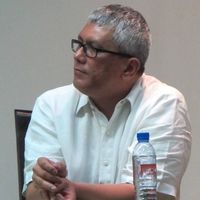Papers by Antonio F . B . de Castro

Philippine Studies, 2022
University of Hawai'i Press: "Writing against historical forgetting, Charlie Samuya Veric recons... more University of Hawai'i Press: "Writing against historical forgetting, Charlie Samuya Veric reconstructs the foundations of Filipino postcolonial thought following Philippine independence from the United States in 1946. On the one hand, he narrates the rise of postcolonial knowledge after the formal birth of the nation. On the other, he examines the ideas of the first generation of intellectuals who came of age after independence—Edith L. Tiempo, Fernando Zobel, Bienvenido L. Lumbera, E. San Juan, Jr., and Jose Maria Sison—whose penetrating insights into literary formalism, modern art, vernacular tradition, subaltern internationalism, and mass revolution constitute key cultural archives of postcolonial knowledge production. Original and provocative, Children of the Postcolony illuminates Filipino decolonization and argues for the vitality of its still unrealized dreamworld."
Philippine Studies, 2010
Contents may not be copied or sent via email or other means to multiple sites and posted to a lis... more Contents may not be copied or sent via email or other means to multiple sites and posted to a listserv without the copyright holder's written permission. Users may download and print articles for individual, noncommercial use only. However, unless prior permission has been obtained, you may not download an entire issue of a journal, or download multiple copies of articles.
Theology, Conflict and Peacebuilding, 2019
It is important to note the historical context of this paper. The "Zamboanga Siege" took place i... more It is important to note the historical context of this paper. The "Zamboanga Siege" took place in September 2013; this paper was based on a talk given more than a year after, when the scars of that siege was still very visible and the wounds had not yet fully healed... Today, the historical facts would need to be supplemented: the National Museum of the Philippines had it seems played a key and crucial role in the recent renovations of the Shrine, a fact that remained hidden in the year the talk was delivered and the paper written. However, the theologico-political framework of this paper remains, in my view, valid and useful for analysis of church-state or religious-political relations.
From the end of the Spanish regime to the beginning of the American period: the state of the Cath... more From the end of the Spanish regime to the beginning of the American period: the state of the Catholic Church in the Philippines
Philippine Studies, Vol. 58, No. 1/2, Festschrift in honor of Fr. John N. Schumacher, S.J. (june 2010), pp. 111-146, 2010
Jesuits grappling with linguistic issues after the end of the Spanish regime...
Drafts by Antonio F . B . de Castro
Written more than 20 years ago...
The growth of the Society of Jesus in North America in the post-restoration period can only be de... more The growth of the Society of Jesus in North America in the post-restoration period can only be described as phenomenal. We cannot of course deal with the history of the American Jesuits and the American Church in great detail here; our interest is rather to set those essential points which can serve as background and context to a proper understanding of the situation of the Maryland-New York Province in the years leading to and including the transfer of the Philippine Mission from the Aragon Province to the northern American province in this century.

There is an almost puzzling absence of accounts of the circumstances surrounding the transfer of ... more There is an almost puzzling absence of accounts of the circumstances surrounding the transfer of the Spanish Jesuits from the Philippine Mission to the Bombay Mission in Philippine documentary accounts, leading one to suspect that an intended or unintended suppression of reports on the event had taken place. It is almost as if the decision was too painful to be recounted, so that an absolute silence was deemed the most prudent response to the decision made by the Society's highest superiors. In any case, Jesuit obedience asserted itself and new chapters would be written in the history of the Philippine and Bombay Missions. German Jesuit Troubles in the Bombay Mission What triggered the change in mission responsibility for the Spanish Jesuits in the Philippines was none other than the outbreak of the First World War and its devastating consequences for Jesuit mission work in general and apostolic endeavours in the Bombay Mission in particular. The war between Great Britain and Germany, each with its own respective group of allies, had its unfortunate effect in lands as far away as India and, in the aftermath, provided the circumstances for changes in the Philippine Mission of the Society of Jesus.

Authors: Patricia P. Lambino, Michael Asis, Dennis Gonzalez, Oliver Dy, Albert Flores, and Anton... more Authors: Patricia P. Lambino, Michael Asis, Dennis Gonzalez, Oliver Dy, Albert Flores, and Antonio F. B. de Castro
Popular religiosity was not among the major themes developed at the Second Vatican Council. There is a single reference to pia exercitia ("pious exercises") in Sacrosanctum Concilium 13, too scant for many of us today who have had the benefit of fifty years of hindsight. According to Filipino liturgist Anscar Chupungco, the topic's minimal presence in the Constitution on the Sacred Liturgy can be explained by the liturgical movement's concern to "sharply [distinguish] between what is liturgical and hence essential to the life of the Church and what is not," in a context where "the value of the liturgy was often eclipsed by popular religiosity." Theologian Luis Maldonado gives a more negative assessment, criticizing the liturgical movement for not "know[ing] how to understand nor appreciate the totality of what we today call religiosidad popular."
The beginnings of the Filipino Jesuits in the period of the transition from the Spanish Jesuits t... more The beginnings of the Filipino Jesuits in the period of the transition from the Spanish Jesuits to the American Jesuits...but still needing editing and expansion (the 2nd half of the 1930s).
Delivered originally as a keynote discourse, subsequently revised and expanded, this essay is inc... more Delivered originally as a keynote discourse, subsequently revised and expanded, this essay is incomplete and still needs further elaboration and grounding in primary and other sources...
a lecture in class, based on an essay written by the late Miguel Bernad SJ, showing a different R... more a lecture in class, based on an essay written by the late Miguel Bernad SJ, showing a different Rizal beyond the usual characaterizations, a Rizal whose years in Dapitan reveal other dimensions of his view of the future of the Philippines...
ongoing revision and rewriting...

[Ongoing revision and rewriting] The year 1898 marks the end of more than 300 years of Spanish s... more [Ongoing revision and rewriting] The year 1898 marks the end of more than 300 years of Spanish sovereignty in the Philippines and the beginning of American military occupation and political tutelage of the Islands. The Spanish-American War was concluded by the Treaty of Paris signed on 10 December 1898, with Spain ceding her ultramarine territories directly to the United States of America (Puerto Rico, Guam and the Philippines), and with Cuba gaining what in effect was an internally flawed and U. S. controlled independence. In play were European and American national prestige and economic interests jockeying for key positions in the international field: in Central America and the Caribbean islands, in Africa, and in the Asia-Pacific region. The last decades of the 19 th century and the first ones of the 20 th century were years of great change and movement in the international scene.
on going revision and editing











Uploads
Papers by Antonio F . B . de Castro
Drafts by Antonio F . B . de Castro
Popular religiosity was not among the major themes developed at the Second Vatican Council. There is a single reference to pia exercitia ("pious exercises") in Sacrosanctum Concilium 13, too scant for many of us today who have had the benefit of fifty years of hindsight. According to Filipino liturgist Anscar Chupungco, the topic's minimal presence in the Constitution on the Sacred Liturgy can be explained by the liturgical movement's concern to "sharply [distinguish] between what is liturgical and hence essential to the life of the Church and what is not," in a context where "the value of the liturgy was often eclipsed by popular religiosity." Theologian Luis Maldonado gives a more negative assessment, criticizing the liturgical movement for not "know[ing] how to understand nor appreciate the totality of what we today call religiosidad popular."
Popular religiosity was not among the major themes developed at the Second Vatican Council. There is a single reference to pia exercitia ("pious exercises") in Sacrosanctum Concilium 13, too scant for many of us today who have had the benefit of fifty years of hindsight. According to Filipino liturgist Anscar Chupungco, the topic's minimal presence in the Constitution on the Sacred Liturgy can be explained by the liturgical movement's concern to "sharply [distinguish] between what is liturgical and hence essential to the life of the Church and what is not," in a context where "the value of the liturgy was often eclipsed by popular religiosity." Theologian Luis Maldonado gives a more negative assessment, criticizing the liturgical movement for not "know[ing] how to understand nor appreciate the totality of what we today call religiosidad popular."